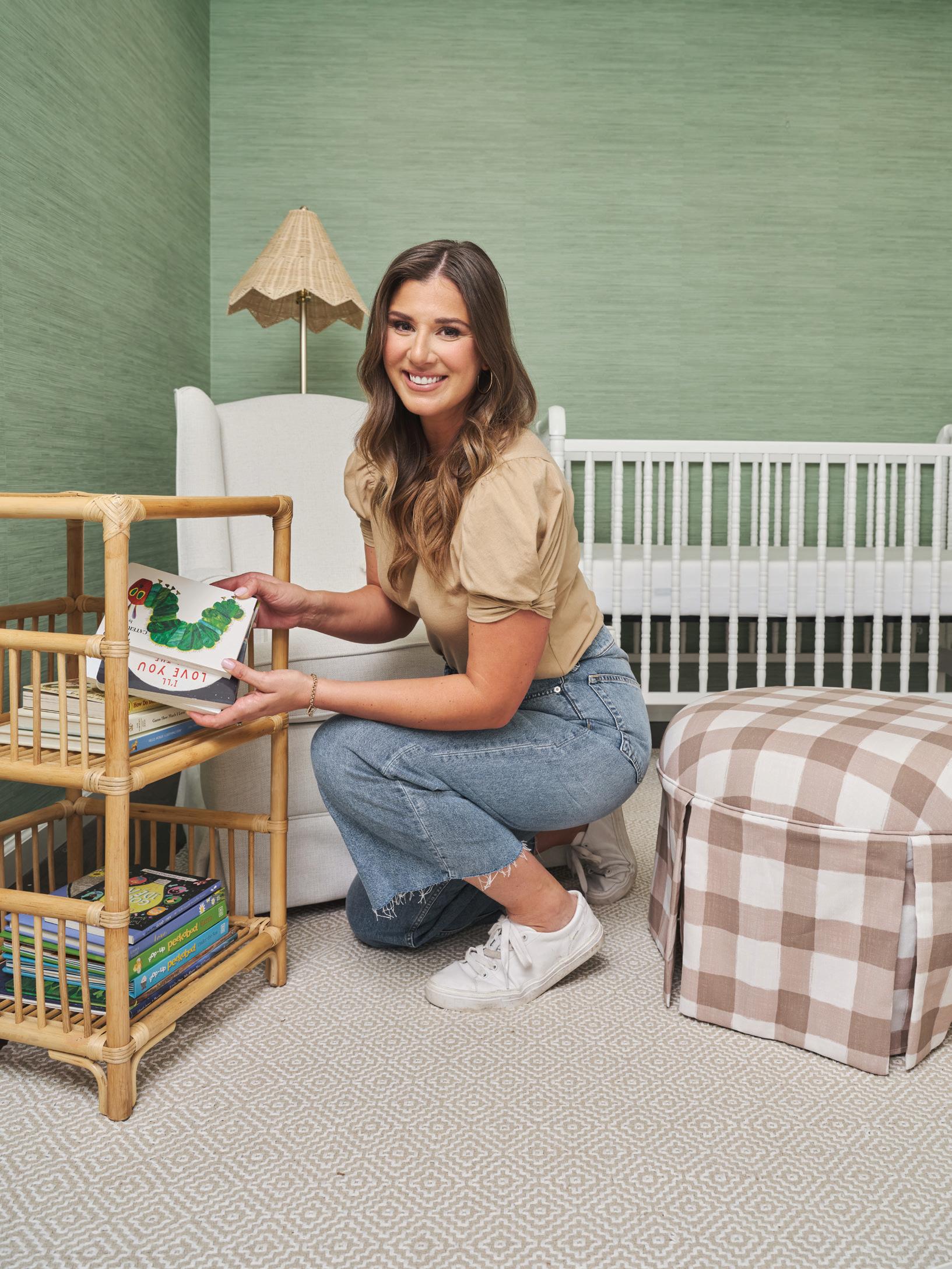
Create Routine-Ready Spaces for Your Baby’s First Years R Í A SAFFORD

Table of Contents FOREWORD by JEN ATKIN 5 INTRODUCTION 6 Let’s Get Real CHAPTER 1 Getting Your Mind Right & Making the Time 12 CHAPTER 2 Preparing Your Home for Baby 22 CHAPTER 3 Planning Your Routine-Ready Space 42 Let’s Get Routine-Ready CHAPTER 4 Nursery & Littles’ Bathroom 58 CHAPTER 5 Parents’ Bedroom & Closet 84 CHAPTER 6 Parents’ Bathroom 112 CHAPTER 7 Living Room & Play Area 136 CHAPTER 8 Kitchen 154 CHAPTER 9 Laundry Room 186 CHAPTER 10 Garage & Mudroom 196 CHAPTER 11 Travel 206 Let’s Review CHAPTER 12 Recap & Reset 226 R ĺ A ’ S PARTING WORDS 232 ACKNOWLEDGMENTS 234 ABOUT THE AUTHOR 238 INDEX 240











Let’s be real: becoming a parent is no joke. Bringing a new baby home can be one of life’s greatest joys, but with it comes a lot of life changes, a lot of responsibilities, and A LOT of stuff.
From clothes to toys, diapers, more toys, and feeding supplies, all the things I’d accumulated in those early months quickly overwhelmed my living space. I knew I needed to get organized, and I knew I wanted a fellow momma who truly “got it” to help me. That’s what led me to Ría Safford, a fellow busy business owner and mom of three whose organizing expertise I’d been obsessed with on Instagram for years. What I didn’t realize at the time was that she came to organize my home just weeks after giving birth—that is serious dedication to your craft.
small spaces, how to organize toys and books, and how to create functional spaces for those times when you need to take a break or get things done while your little one is napping.
One of the most important things that I’ve learned as a new parent is the importance of being intentional with your space. When you have a baby, your home suddenly takes on a whole new level of importance. The nesting is real. It becomes a place where you’ll spend countless hours bonding and cuddling your little one. It’s a place where you’ll make memories to be cherished for years to come. And that’s why it’s so important to create a space that feels peaceful, calm, and joyful.
Ría’s advice will help you achieve just that. Her tips and tricks in this book are easy to implement and won’t take up too much time from your already packed schedule. Because let’s be honest: you’re too busy changing diapers, feeding your little one, and trying to get some sleep whenever you can.
That’s why she’s the perfect person to guide you on this journey. Within this book, Ría will help you navigate the challenges of new parenthood and help you to create a home that works for your growing family’s routines and needs. She’s got practical tips and strategies that you can easily implement, as well as inspiration and ideas to help you create a beautiful and organized space that you can actually maintain on your own.
Ría covers everything from nursery organization to pantry storage to closet decluttering, and she offers plenty of tips on how to make the most of
I’m so proud of Ría for writing this book, and I’m so incredibly grateful for all the ways she’s made my family’s home life better. If you’re a soon-to-be parent or a new parent fretting about how to manage life with your newborn, take a deep breath and dive into this book. Ría is here to make your life a little bit easier, one organized space at a time.
–JEN ATKIN Founder of OUAI & Mane Addicts
5
If there’s anyone who understands the chaos and clutter of a family in your home, it’s Ría.
FOREWORD

THE ORGANIZED HOME FOR NEW PARENTS 6
I’m a Messy Person at Heart.
Tidiness and organization never came naturally to me. It wasn’t until after I’d given birth to my first child that I truly understood the impact of an organized home. I was twenty-four years old and newly married when Landry came into the picture— thrusting us headlong into the whirlwind of parenthood a full nineteen days early. Needless to say, I wasn’t prepared. The reality is that most of us aren’t when we become parents. Whether you’re a first-time parent or this is your second, third, or fourth go at this, you know how truly unpredictable life becomes with a new baby. Then comes all the crap . . . clothes, toys, baby bouncers, blankets, strollers, cribs, car seats, bottles, and, of course, diapers—and all the actual poop that can seem endless with little kids. All of the sudden, my life was a mess—a beautiful mess, but a mess. As the utter chaos of everyday life spilled into my home, I felt as if I was drowning in the middle of it all.
The disaster state of my home spread to all areas of my life. I was flailing as a mom, a wife, and an employee. I imagine that most new parents have had that feeling—like you’re dropping all the balls at once, and that you’re letting everyone down. After a week of sleepless nights, fighting to make it from one sunrise to the next, I had finally hit my breaking point. I remember the moment so clearly: it was two o’clock in the morning when I woke to Landry’s hunger cries and her blowout diaper. Frantically trying to navigate her nursery in the dark, I couldn’t find anything I needed: wipes, diapers, a clean onesie, fresh sheets, you name it. I was trying to live this new chapter the way I had lived the previous one—flying by the seat of my pants—and it wasn’t working. I broke. I woke up Conner, hysterical and falling apart. Not only did I think I would never sleep again, but I also felt that I had failed everyone and everything.
At that moment, I decided I needed to prioritize organization at home if I wanted to keep my life on track. I’ve shared this part of my journey to convey that it doesn’t matter whether organization comes naturally to you. You can start from anywhere, and you might be surprised where you land. My own experience inspired me to start a business and ultimately to write a guide to organizing specifically for you: expecting parents and those in the beginning stages of raising young kids.
7 INTRODUCTION
This phase in a family’s life can be the most challenging, and it requires tricks unique to streamlining a home when babies (and all their stuff and schedules) become a huge part of the daily routine.
Organizational systems can be learned, mastered, and implemented in your everyday life.
Establishing your own methods of organizing will make your days more purposeful and less stressful, which allows you to be the best version of yourself. I am here to help you bring those systems into your own life.
I am Ría Safford, mother of three (Landry, Sawyer, and Jack); wife to my proud Texan husband, Conner; and the CEO and founder of RíOrganize, a professional home organization and relocation company. In addition to thousands of families like yours and mine all over the country, we have helped organize spaces for Oscar, Grammy, Tony, and Emmy winners; Hall of Fame athletes; Olympians; CEOs; and industry leaders. Pinch me! Ten years ago, never would I have thought—especially when I was still shoving all the contents of my messy room into an overstuffed closet before guests came over—that so many successful people would entrust me with their home organization goals. That’s right, I went from being the captain of the Hot Mess Express to organizing for the world’s elite in just seven years. In our early talks, my publisher asked me how much time I’ve put into mastering home organizing for families. At last check, I’d tallied 15,287 hours—according to Malcolm Gladwell’s “10,000-hour rule,” I made expert status over 5,000 hours ago! So, I’m here to offer you all my tips, tricks, and secrets to set you up for success.
The truth is, parents and caregivers end up being professional organizers in their own home no matter what. There is no job that requires more purposeful planning and execution than being a parent. And while you can become a parent overnight, getting organized is not an overnight task. It’s a lifestyle. It’s an attitude, a mindset, a commitment. Just like with any other lifestyle journey—be it a new diet, an exercise plan, or taking up a new hobby or interest—you have to show up for yourself. And if you implement this lifestyle now, when your children are young, you will be set up for success as your family grows and evolves through the various milestones.
No project is the same, no space is the same, no solution is the same. BUT—and this is a big butt, think J-Lo booty—the questions we ask about the space in order
THE ORGANIZED HOME FOR NEW PARENTS 8
to find the solution are the same. I will walk you through those questions, help you analyze the routines that unfold in a given space, and evaluate how to best utilize that space to make it an efficient, and dare I say pleasant, part of your day. Once we cover the foundations, we will work through your house room by room. By the end of the book, your entire home will be organized and routine-ready!
But first I need to make something abundantly clear. If you are disorganized, if your house is cluttered, if you feel as if you are drowning your way through some of life’s moments, know this: there is nothing wrong with you. You might have a broken system, a poorly functioning space, or a new mountain of stuff that got dropped onto the end of the never-ending to-do list, but it is the system that is broken, not you. This book provides you with an opportunity to reintroduce yourself to your belongings, purposefully decide what stays and what goes, and streamline your home and life so you can truly enjoy this time with your young child.
The key is creating a maintainable system. As I said before, this is not a one-off quick fix; it’s a lifestyle change. Some days, it’ll look like a bomb went off in the kitchen or playroom, but if you have your system in place—organizational structure designed to meet your specific needs for that specific space—then reclaiming that space will take mere minutes rather than hours. Remember: your home is an everyday, never-ending project that is always evolving as your family evolves.

By picking up this book, you have officially made organization a priority. This is a huge step, and the positive effects will ripple throughout all aspects of your life! So, get ready to create the most functional and routine-ready spaces for you and your family. I will be here to guide you, keep things realistic, and manage expectations. Projects get delayed, budgets change, life happens. There’s always a work-around. Let’s make your space one that you are proud of. You’ve got this!
HAPPY ORGANIZING!
INTRODUCTION 9


PART ONE INTRODUCTION
Let’s Get Real

CHAPTER 1 Getting Your Mind Right & Making the Time
Getting Your Mind Right & Making The Time
Parenting an infant or a young toddler is one of the most challenging stages in life. Many of us are sleep-deprived, our time and energy stretched too thin—all while trying to show up as the best version of ourselves for our children, our partners, our other family members, our friends, and our jobs. At first, it might seem hard or even ridiculous to prioritize organizing our homes when we’re overwhelmed by all the things we have to do just to get through each day. If you feel that way, you are not alone, and I hear you.
The strategies in this book are comprehensive and universal, but most importantly they are flexible and adaptable to you and
your lifestyle—before or after you bring a newborn home. You don’t need to commit to organizing your entire house to reap the benefits; anything you can do to chip away at creating order and calm out of havoc will make your life easier. When we live in calm, organized environments, we are calmer parents who are more freed up to make guilt-free memories with our new or growing families. Keep that in mind as you read on, especially if you begin to feel overwhelmed by the mounds of clutter to sort through. Whatever you can do, whenever you can do it, is enough.
13
Get into the Mindset
First things first, your mind is your most powerful tool. Framing things in the right way can make all the difference. So, it’s time to get into the organizing mindset, which means embracing the experience ahead. At times, you might feel overloaded by the mountain of to-do lists already on your plate and want to give up. In these moments, it’s helpful to recall why becoming an organized parent will make your life so much easier: The more organized you are as a parent, the more time you will have for things that truly matter.
You’ll have more energy to get things done and to create the home you want to live in. A calm retreat from the mayhem of the world? A bright, fun-filled pad where you can easily host friends and family at the drop of a text? It’s all achievable—even as parents of young children—starting from scratch. Your mindset and attitude will determine the success of this undertaking. For sure, take that break when you need to! Just remember that bringing positivity to the areas in your life that you can control will make a huge difference.
As new parents, not only are we tired and overwhelmed, but we often feel as though we’re falling behind, or we’re worried we aren’t doing a “good enough” job. In my work with parents, I quickly learned that they didn’t need another person reaffirming what they already knew about their stresses; they needed a cheerleader, someone to re-energize them and help them see the light at the end of the tunnel. So that’s exactly what I became for them and what I want to do for you. So, whether you’re an expecting parent or you’re already wrangling a toddler, this book will support your efforts to live a calmer and more joyful life. Though it can feel daunting to take on more work, channeling the right mindset now and following through on the projects most relevant to your life will empower you to spend more time doing things you truly enjoy, like bonding with your children.
Before we get into organizing your space, we are going to organize your thoughts. Organization isn’t a copy-and-paste solution. Though the approach to organization is the same, the outcome is always different. Why? Because the variable is you. Determining your goals and your why from the outset not only keeps you motivated, but it also keeps you on track.
THE ORGANIZED HOME FOR NEW PARENTS 14

WHY AM I DOING THIS?
Start By Asking Yourself the Following Questions:
WHAT AM I HOPING TO ACHIEVE BY THE END OF THIS PROJECT?
HOW DO I WANT MY HOME TO FEEL FOR ME AND MY CHILDREN?
Everyoneʼs idea of organization is different.
WHY AM I DOING THIS?
SOME MIGHT SAY:
I don’t even know where to start with creating an organized home.
OTHERS MIGHT SAY:
I am a naturally organized person, but I don’t know how to transition my space as I grow my family.
WHAT AM I HOPING TO ACHIEVE?
SOME MIGHT SAY:
An easy-to-maintain system that grows with my family.
OTHERS MIGHT SAY:
I hope to achieve a home that can be reset quickly and efficiently.
HOW DO I WANT MY HOME TO FEEL?
SOME MIGHT SAY:
Dare I say it . . . peaceful.
OTHERS MIGHT SAY:
I want my home to feel fun and lively but stress-free.
THE ORGANIZED HOME FOR NEW PARENTS 16
While our organizing goals may vary, it’s important to start by grounding our expectations. There is a difference between “clean” and “functional.” There is often an even bigger difference between “stylish” and “functional.” This is where social media, for all of its benefits, can be harmful. We have been programmed to assume that when a space is sophisticated, clean, and beautiful, it must be a well-organized space. FALSE!
There is no correlation between cleanliness—or stylishness—and functionality. And functionality is the goal!
Many of the most aesthetically pleasing spaces were not designed with function in mind, and that oversight can set someone up for major stress when that initial “wow” factor wears off. In the same vein, some of the least photogenic spaces are actually some of the most functional. Organized chaos is real: some people have fantastically functional systems that may look cluttered to an outside eye. (Conner, looking at you. Clean your desk, love.) The point is, you can’t actually tell whether something is functionally organized just by looking at the space. So much of functionality comes down to the usability of the space.
Now that you know your goals, let’s think about your hurdles—or what I like to call pain points. A pain point is a broken link in your system. It is an area, habit, or visual that causes you mental or emotional pain or stress to be around or think about. Put simply, it’s what is not working in your space. Pain points can be as minor as “It takes me forever to find the right caps to my baby bottles!” to “None of my kids’ socks match.” It can be as broad as “I can never find anything!” or “The living room is constantly cluttered with toys!” Once you identify your pain points, we can begin to heal them.
Let’s pen those pain points: for your work in this book, you can keep a pen and pad on hand or use a notes app in your phone. When we write something down, especially something that carries a negative weight, it helps us air it out, release it, and accept it, which is the first step toward change. Once you can accept something as the source of your frustration, you can actually do something about it! Plus, it will be fun to look back at this list after tackling your spaces as a reminder of how far you’ve come.
GETTING YOUR MIND RIGHT & MAKING THE TIME 17
Make the Time
The other component that’s just as important as your mindset is making the time. You must give yourself enough time to tackle each project. This means you’ll need to create the time if it doesn’t currently exist within your hectic schedule. I’ve learned that there is always time to be found—yes, even as a parent of little ones! First, sit down with your partner or spouse to discuss your home-organizing priorities and how you’ll support one another in those efforts. Consider taking some time at dinner every Sunday night to discuss goals for the coming week and how you’ll break those goals into manageable to-dos. You may need to make some sacrifices, but I promise, I promise, I promise it will all be worth it. The end result will be a more routine-ready space, which will actually save you tons of time in the long run.
You’re probably thinking,
“Well, how much time do I need to make, Ría?”
Great question. The amount of up-front time required depends on the space and the scope of the project within it. In an ideal world, you would have endless time to clear out your home, sending the kiddos off to Granny’s, working through one space to the next until your whole home makes Joanna Gaines envious, right? HA! Reality check! That’s not a realistic option for most of us, who have to work within the limited time constraints we have. Whether you can stop everything to do a complete home overhaul, or you plan to tackle bite-sized projects over the course of the following months (or years!), don’t worry. Both scenarios will accomplish the same goal, even if on different timelines.
Here are some questions to consider for finding the time, especially when you are the primary caregiver:
• Can I spend a few hours once a week after putting my child to bed to focus on projects?
• Can my partner and I switch off taking the kids to the park and working on our organizing project on the weekends?
• How can I use nap time to tackle these smaller organizing projects I’ve had on my mind?
THE ORGANIZED HOME FOR NEW PARENTS 18

TIME TIP #1
Only take on tasks that can be started and completed in one session.
What could possibly be worse than whatever pain point you already have? Let me tell you: starting to empty, sort, and categorize a space, only to stop mid-project, with clutter left, right, everywhere. If the space was under-functioning before, now it’s likely completely unusable. Rather than finding yourself in this frustrating limbo, consider what your schedule allows you to accomplish, then tackle a space or project that you can complete within that window of time.
If you only have an hour, don’t tackle the entire pantry; instead, consider setting up a drawer for baby bottles and pump parts or organize the pajamas in your child’s dresser. Whatever project you decide to take on, make sure you give yourself enough time to complete it!
TIME TIP #2
Get a feel for the pace at which you work.
Start with a small but contained space, like your essentials drawer. “Ría, my what?” Oh, I am so glad you asked! I’m referring to what most of you call your “junk drawer.” Because intention and attitude are a huge part of how we perceive our space and our lives, if we call something a “junk” drawer, we’re likely to fill it with junk! But who needs junk? If we shift our perspective and call it what that drawer should be, an “essentials” drawer, then you’ll end up using it for essentials.
Starting with a small space that contains a finite project, you’ll get a sense for how quickly you work when organizing something from start to finish. Some people go at rapid speed, never stopping to think—they just want it DONE. Others take their time, considering each object (maybe feeling torn about what to keep and what to toss). We all go at our own pace. Use this as your trial run to better plan out the time you’ll need for other projects in the future.
Another reason to start small? Small victories, one after the other, help us build up confidence. Positive results beget more positive results. This is the snowball effect for organizing. Pile up those small victories, and you will be amazed at how big of an impact you’ve already had on organizing your home.
THE ORGANIZED HOME FOR NEW PARENTS 20
TIME TIP #3
Be smart with your time.
Being smart with your time simply means that you have a damn plan. If you go into any project with an “I’ll just wing it” mentality, it is going to take much longer than it needs to. The process will inevitably become frustrating, or you will lose interest, or you will get distracted by that book of photos you found halfway through. Have a plan, set a goal, then execute the plan until you’ve achieved the goal.
For example, if you’ve had a baby recently, chances are you were gifted tons of bottles, or maybe you bought a bunch to test out which ones worked best for you and your child. To streamline your stash, use each one over the course of a week or two and only keep the ones that are most functional—the ones that don’t leak, ones with matching tops, ones with corresponding nipples your baby prefers. If you only reach for a handful of them, get rid of the ones that just collect dust and take up valuable space in your kitchen.
One last piece of advice before we get started . . .
CHECK YOUR JUDGMENT AT THE DOOR
All too often, we completely avoid a goal or project because we don’t know where, or how, to start. That sense of hopelessness or of being overwhelmed can prevent people from ever trying to make a change at all. This attitude can also prevent us, as parents, from prioritizing our needs and getting the support we deserve. For example, in those early weeks of new motherhood, I pushed off visitors because I was embarrassed for them to see the house in disarray. But I learned that they couldn’t care less about whether the floor was swept or the clothes were put away. They just wanted to support me and meet the newest addition to the family.
To avoid this mindset, stop judging yourself! It does not matter if things are out of place here and there, or even if it looks like Hurricane Newborn just swept through your living room. This is your opportunity to make a change and start anew, so embrace the challenge. The success of this journey is proportional to the attitude you bring to it. Leave the judgment at the door, roll up your sleeves, and get ready to work.
GETTING YOUR MIND RIGHT & MAKING THE TIME 21






















